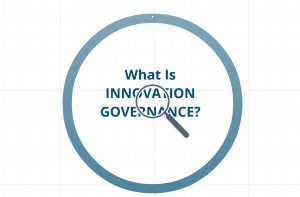
Previous posts explained the growing importance of innovation governance and that it is not getting enough attention by Boards and C-Suite executives. Now let’s take a closer look at just what it is.
I think a good start is perhaps the world expert on the subject, Emeritus Professor Jean-Philippe Deschamps at the IMD Business School. He states:
Innovation governance provides a frame that defines the mission, focus and implementation of innovation in the company. It starts with establishing a set of policies regarding the scope of innovation and addressing a number of questions dealing with both ‘content’ (i.e. projects) and ‘process’ (i.e. approaches and responsibilities).
Seems similar to corporate governance? Yes it is. Some describe innovation governance as a subset of corporate governance. Perhaps, but I believe that since innovation transcends all corporate departments and directly impacts risk and performance, it should be embedded within corporate governance. In my eBook Everything You Need to Know About Business Creativity and Innovation, I outline a typical corporate innovation process and now indicate which components have corporate governance implications–
| Innovation Process Components | Corporate Governance Implications |
| To create a safe space for innovation, CEOs must invest in creating an environment that allows innovation to thrive while encouraging employees to feel comfortable taking calculated risks | YES |
| Teach senior management and project team members the mind-sets and behaviors that foster disruptive growth | YES |
| Provide employees with a process manual, a step-by-step guide to creating ideas and innovation. The manual includes overarching principles as well as detailed procedures and templates to help teams describe opportunities, identify requirements for success, monitor progress, make go/no go decisions, and work with integrity | YES |
| Offer employee creativity training | |
| Create an innovation strategy: innovation activities should be focused around achieving corporate goals and that identifies how innovation will build on current success to achieve corporate goals | YES |
| Stimulate ideas: innovation opportunities are everywhere, sometimes hiding just below the surface | |
| Create programs to trigger employees, customers and partners to contribute innovation ideas that align with the innovation strategy goals | |
| Identify the best opportunities: the benefits of innovation are increased by focusing on the best opportunities. Develop criteria to evaluate innovation opportunities and create an open selection process to decide which to implement. Ensure that the few projects selected are properly resourced and implemented in a timely fashion with results communicated to stakeholders | YES |
| Implement with speed: innovations only provide value when they are implemented. Failure to implement good ideas promptly is one of the biggest barriers to building an innovation culture | |
| Provide incentives and rewards: show employees that their contribution is valued, both for good ideas and successful implementation. Make sure that failures are seen as learning opportunities, not causes for punishment. Recognizing innovators sends other employees a powerful signal that innovation is something that the company greatly values | YES |
| C-level managers must walk the talk: a corporate push to innovate loses its momentum quickly if the inspirational words are not backed up with action | |
| Measure the performance of the innovation process itself and look for opportunities to refine and improve it | YES |
This indicates that innovation should be an important component of corporate governance.
Back to Professor Deschamps who recommends the following responsibility elements for innovation governance:
- Defining roles and ways of working around the innovation process
- Defining decision power lines and commitments on innovation
- Defining key responsibilities of the main players
- Establishing the set of values underpinning all innovation efforts
- Making decisions that define expectations
- Defining how to measure innovation
- Making decisions on innovation budgets
- Orchestrating, balancing and prioritizing innovation activities across divisions
- Establishing management routines regarding communications and decisions.
Next we will look at the vital leadership role of the Board and the C-Suite in advancing innovation governance in the enterprise.
Lucy is Editor at Corporate Eye


